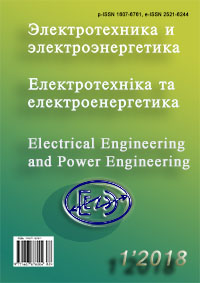CONTACT RESISTANCE MODELING
DOI:
https://doi.org/10.15588/1607-6761-2018-1-3Keywords:
contact resistance, real area, electric potential, nuclear membraneAbstract
Purpose. To determine the contribution of the real contact spots distribution in the total conductivity of the conductors contact.
Methodology. The electrical contact resistance research was carried out on models. The experimental part of this work was done on paper with a graphite layer with membranes (the first type) and conductive liquids with discrete partitions (the second type).
Findings. It is shown that the contact electrical resistance is mainly determined by the real area of metal contact. The experimental dependence of the electrical resistance of the second type model on the distance between the electrodes and the potential distribution along the sample surface for the first type model were obtained. The theoretical model based on the principle of electric field superposition was considered. The dependences obtained experimentally and calculated by using the theoretical model are in good agreement.
Originality. The regularity of the electrical contact resistance formation on a large number of membranes was researched for the first time. A new model of discrete electrical contact based on the liquid as the conducting environment with nuclear membrane partitions was developed. The conclusions of the additivity of contact and bulk electrical resistance were done.
Practical value. Based on these researches, a new experimental method of kinetic macroidentation that as a parameter of the metal surface layer deformation uses the real contact area was developed. This method allows to determine the value of average contact stresses, yield point, change of the stress on the depth of deformation depending on the surface treatment.
References
[1] Nitsenko, V., Kulagin, D., & Makhlin, P. (2016). Investigation of errors of current transformers in the protection systems in steady and transient conditions of energy system. Electrical Engineering And Power Engineering, 2, 59-71. doi: http://dx.doi.org/10.15588/1607-6761-2016-2-7. [in Ukrainian]
[2] Barber, J.R. (2003). Bounds on the electrical resistance between contacting elastic rough bodies. Proceedings of the Royal Society of London A, 459, 53-66.
[3] Sawada, S., Shimizu, K., Shimada, S., Hattori, Y. (2010). Prediction of Electrical Contact Resistance of Tin-plated and Silver-plated Terminals. SEI Technical Review, 71, 37-43.
[4] Janiszewski, J., Ksiazkiewicz, A. (2014). Vacuum switches contact resistance. Computer Applications in Electrical Engineering, 12, 227-236.
[5] Kogut, L., Komvopoulos, K. (2003). Electrical contact resistance theory for conductive rough surfaces. Journal of Applied Physics, 94, 31-53.
[6] Pennec, F., Peyru, D., Leray, D., Pons, P., Plana, R., Courtade, F. (2012). Impact of the surface roughness description on the electrical contact resistance of ohmic switches under low actuation forces. IEEE Transactions on Components and Packaging Technologies, 2(1), 85-94.
[7] Korotkevich, S.V., Holodilov, O.V. (2017). Ocenka tolshhiny smazochnogo sloja v podshipnikah kachenija jelektrorezistivnym metodom [The evaluation of the lubricating layer thickness in rolling bearings by an electric resistive method]. Materialy 6-j mezhd. nauch.-tehn. konf. “Sovremennye metody i pribory kontrolja kachestva i diagnostiki sostojanija ob’ektov”. Mogilev: Belorussko-Rossijskij universitet, 382-388. [in Russian]
[8] Duraj, A., Mach, P. (2008). Analysis and Prediction of Electrical Contact Resistance for Anisotropic Conductive Adhesives. Proceedings of 31th ISSE “Manufacturing processes, process simulation and optimization”. Budapest, 358-362.
[9] Pavlenko, T.P. (2013). Opredelenija parametrov sostava kompozicii psevdozhidkometallicheskih kontaktov po matematicheskoj modeli [The determination of the composition parameters of pseudoliquid-metal contacts according to the mathematical model]. Elektro-tehnіka ta elektroenergetika, 1, 14-18. [in Russian]
[10] Read, M.B., Lang, J.H., Slocum, A.H. (2009). Contact Resistance in Flat Thin Films. Proceedings of the 55th IEEE Holm conference on Electrical Contacts, 303-309.
[11] Murashov, M.V., Panin, S.D., Klimov, S.M. (2015). Chislennoe modelirovanie jelektricheskoj provodimosti kontaktov sherohovatyh tel [The numerical simulation of electrical conductivity of the rough body contacts]. Nauka i obrazovanie MGTU im. N.Je. Baumana, 1, 189-200. [in Russian]
[12] Zhai, C., Hanaor, D., Proust, G., Gan, Y. (2015). Stress-dependent Electrical Contact Resistance at Fractal Rough Surfaces. Journal of Engineering Mechanics, 5, 13-19.
[13] Hol'm, R. (1961). Jelektricheskie kontakty. M. Inostrannaja literature, 464.
[14] Demkin, N.B., Ryzhov, Je.V. (1981). Kachestvo poverhnosti i kontakt detalej mashin. M. Mashinostroenie, 244.
[15] Pavlejno, O.M., Pavlov, V.A., Pavlejno, M.A. (2010). Utochnenie granic primenimosti hol'-movskogo priblizhenija dlja rascheta soprotivlenija jelektricheskih kontaktov [The refinement of the applicability limits of the Holm approximation for calculating of the electrical contact resistance]. Jelektronnaja obrabotka materialov, 5, 56-62. [in Russian].
[16] Zatovskij, V.G., Minakov, N.V. (2010). Jeksperimental'noe modelirovanie soprotivlenija stjagivanija [The experimental simulation of the contraction resistance]. Jelektricheskie kontakty i jelektrody, 5, 132- 138. [in Russian]
[17] Flerov, N.B., Barashenkov, V.S. (1974). Prakticheskie primenenija puchkov tjazhelyh ionov [Practical applications of heavy ion beams]. Uspehi fizicheskih nauk, 2, 351-373. [in Russian]
Downloads
Published
How to Cite
Issue
Section
License
Copyright (c) 2018 LOSKUTOV S. V., SCHETININA M.O., ZELENINA O. A.

This work is licensed under a Creative Commons Attribution 4.0 International License.
Creative Commons Licensing Notifications in the Copyright Notices
Authors who publish with this journal agree to the following terms:
Authors retain copyright and grant the journal right of first publication with the work simultaneously licensed under aCreative Commons Attribution License that allows others to share the work with an acknowledgement of the work's authorship and initial publication in this journal.
Authors are able to enter into separate, additional contractual arrangements for the non-exclusive distribution of the journal's published version of the work (e.g., post it to an institutional repository or publish it in a book), with an acknowledgement of its initial publication in this journal.
Authors are permitted and encouraged to post their work online (e.g., in institutional repositories or on their website) prior to and during the submission process, as it can lead to productive exchanges, as well as earlier and greater citation of published work.

